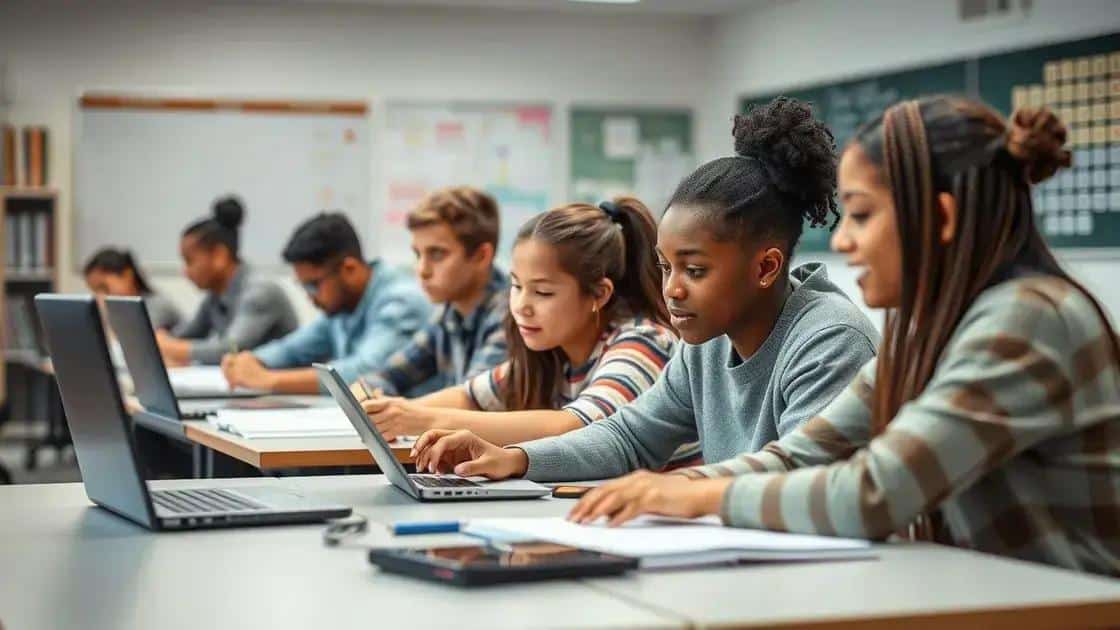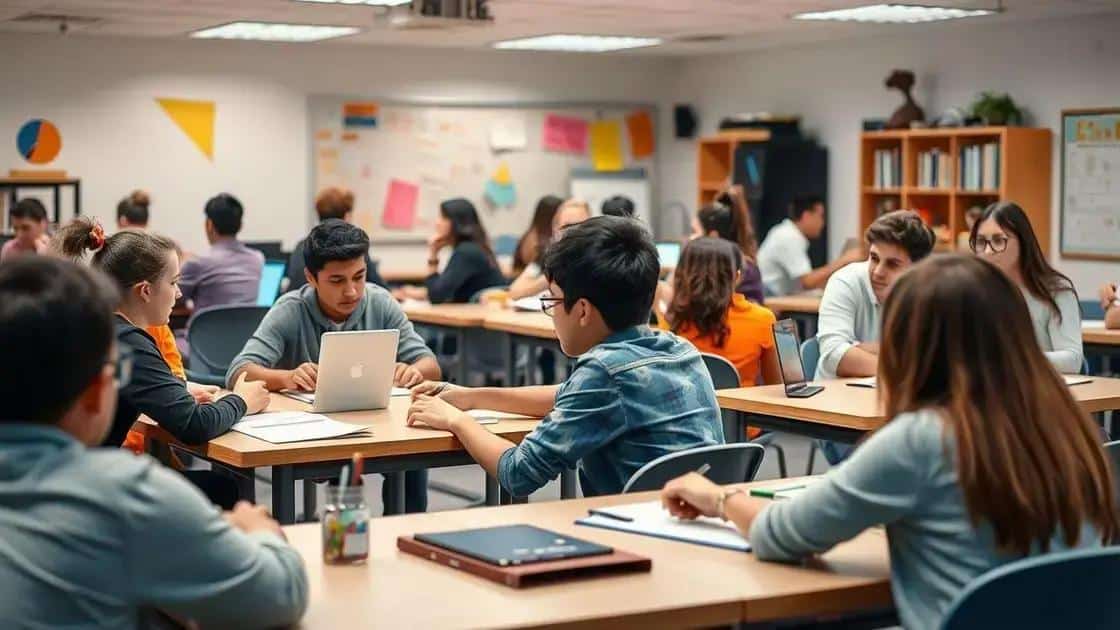Patterns in academic success: 2025 update

Improving academic performance involves setting clear goals, using effective study techniques, building strong relationships with teachers, and involving parents in the learning process.
Patterns in academic success are evolving rapidly, especially in 2025. It’s fascinating to see how different factors come into play in shaping student experiences. What does this mean for future educational strategies? Let’s dive into the details.
Defining academic success in today’s context
Defining academic success today means looking beyond just grades. It’s about understanding how students engage with their learning and the skills they acquire. Many factors contribute to this definition and help shape the educational landscape.
One essential aspect to consider is how we measure academic success in contemporary education. It often includes a mix of performance indicators such as exam scores, project completions, and critical thinking skills.
Different Perspectives on Success
Academic success varies for each student, influenced by their background, interests, and resources. Some key perspectives include:
- Personal Growth: Improving skills and knowledge over time.
- Social Engagement: Participating in group projects and discussions.
- Emotional Well-being: Feeling safe and supported in the learning environment.
Teachers also play a vital role in shaping how students perceive success. They provide feedback and guidance, helping students recognize their progress.
Moreover, educational institutions are increasingly focusing on holistic approaches. They emphasize teaching critical life skills, such as collaboration and resilience, alongside academic content.
Factors Influencing Current Definitions
Several factors influence how we define academic success today, including:
- Technology: Digital tools enhance learning experiences and accessibility.
- Globalization: Exposure to diverse cultures and ideas boosts creative thinking.
- Community Support: Involvement from families and communities can drive student motivation.
As we adapt to a rapidly changing world, understanding academic success requires flexibility. Emphasizing diverse learning outcomes helps prepare students for future challenges.
Key factors influencing learning outcomes
Understanding the key factors influencing learning outcomes is essential for improving education. These factors can dramatically affect how students perform in school and their overall academic success. They range from individual characteristics to broader systemic issues.
One of the primary influences is the motivation of students. When learners are motivated, they engage more deeply with the material, leading to better understanding and retention of information. Motivation can stem from personal interests, teacher encouragement, and the learning environment.
Environmental Influences
The environment where a student learns also plays a critical role. Factors such as class size, classroom layout, and accessibility to resources can impact student performance. A supportive and resource-rich environment fosters engagement and effective learning.
- Classroom Culture: A positive atmosphere encourages participation.
- Access to Technology: Tools like computers and tablets can enhance learning experiences.
- Parental Involvement: Active involvement from parents often boosts student confidence and performance.
Teacher effectiveness is another critical factor influencing learning. Experienced and well-trained teachers can inspire and motivate students effectively. They understand how to adapt lessons to meet the diverse needs of their students, ensuring everyone has a chance to succeed.
Furthermore, each student’s background and personal circumstances contribute to their learning experience. Factors such as socioeconomic status, cultural background, and prior educational experiences shape how students approach learning tasks.
Personal and Social Factors
In addition to the environmental and teacher-related factors, personal and social aspects also play important roles. Students need healthy emotional and social skills to interact well with peers and teachers. This can lead to improved collaboration and support within the classroom.
- Emotional Support: A caring environment helps reduce anxiety and promotes learning.
- Peer Relationships: Good friendships can motivate and engage students in learning.
- Self-Regulation: Students who can manage their time and emotions often perform better academically.
By understanding these key factors influencing learning outcomes, educators can create more effective strategies for enhancing student success. This holistic approach helps to address not just academic skills but also the personal development of each student.
Emerging trends in student engagement

Emerging trends in student engagement are transforming how learners interact with their studies. As education evolves, schools are adopting new methods to enhance student participation and motivation. These trends focus on creating a more inclusive and stimulating learning environment.
One significant trend is the use of technology in the classroom. Digital tools allow for interactive lessons, enabling students to explore content in engaging ways. This enhances their learning experience and fosters a sense of ownership over their education.
Collaborative Learning
Another notable trend is collaborative learning. This approach encourages students to work together, share ideas, and solve problems as a team. Benefits of collaborative learning include:
- Enhanced Critical Thinking: Students learn to evaluate different perspectives and develop their ideas.
- Increased Communication Skills: Working in groups improves verbal and non-verbal communication.
- Stronger Relationships: Students build connections with peers, fostering a supportive community.
Additionally, gamification is becoming popular in educational settings. By incorporating game-like elements into lessons, educators can motivate students and make learning fun. Students are more likely to engage with material that feels like a game, which often leads to better retention of information.
Personalized Learning Experiences
Personalized learning is also on the rise. It tailors education to meet individual student needs, allowing them to progress at their own pace. This approach can include:
- Customized Learning Plans: Each student has a unique plan that suits their learning style.
- Varied Assessment Methods: Students can demonstrate their understanding in multiple ways.
- Flexible Learning Environments: Allowing choices in how and where they learn fosters independence.
As we look at the future, it’s evident that the focus on student engagement will continue to grow. Schools are prioritizing practices that encourage active participation, critical thinking, and a love for learning. These trends signify a move towards a more dynamic and responsive educational system that values each student’s journey.
The role of technology in education
The role of technology in education has grown immensely in recent years. It is reshaping the way students learn and how teachers instruct, making education more accessible and engaging for all. By integrating technology into the classroom, educators can create interactive learning experiences that captivate students.
One of the significant benefits of technology is the access to vast resources. Students can engage with digital libraries, educational videos, and online courses that expand their knowledge beyond traditional textbooks. This wealth of information promotes self-directed learning, allowing each student to explore subjects of interest at their own pace.
Interactive Learning Tools
Another advantage of technology is the use of interactive learning tools. Applications and software designed for education can enhance classroom experiences. Examples include:
- Virtual Simulations: These provide hands-on experiences in subjects such as science and engineering.
- Educational Games: Engaging games can make learning fun and motivate students.
- Online Collaboration Platforms: Tools like Google Classroom allow students to work together on projects, even from different locations.
Technology also supports personalized learning. With adaptive learning programs, students receive customized content based on their strengths and weaknesses. This tailored approach helps address the unique needs of each learner, promoting better academic outcomes.
Teacher Support and Professional Development
Teachers benefit from technology as well. It simplifies lesson planning, provides easy access to digital resources, and facilitates communication with students and parents. Professional development opportunities through online courses help educators stay current with teaching methods and technological advancements.
However, the integration of technology comes with challenges. Not all students have equal access to devices and high-speed internet, which can create disparities. Educators must address these gaps to ensure that every learner benefits from technological advancements. Overall, the role of technology in education continues to evolve, promising exciting possibilities for future learning.
Strategies for improving academic performance
Improving academic performance is a goal for students, teachers, and parents alike. To achieve this, several effective strategies can be implemented both inside and outside the classroom. These strategies not only enhance learning but also promote a positive educational experience.
One strategy is establishing clear goals. When students set specific, measurable, and achievable goals, they can focus their efforts on what really matters. This process helps them track their progress and stay motivated throughout their academic journey.
Effective Study Techniques
Implementing effective study techniques is crucial for academic success. Students can benefit from:
- Active Learning: Instead of passively reading, they should engage with the material through discussions and practical applications.
- Time Management: Creating a study schedule can help students allocate time effectively for each subject, reducing stress and improving retention.
- Variety in Study Methods: Using flashcards, quizzes, and study groups can keep learning dynamic and engaging.
In addition, fostering a positive learning environment is essential. This includes ensuring that students have access to necessary resources, like books and technology. A supportive atmosphere encourages students to ask questions and seek help when needed.
Building Strong Relationships
Building strong relationships with educators can also enhance academic performance. When students feel comfortable with their teachers, they are more likely to participate in class and seek assistance. Open communication allows students to express their challenges, and teachers can provide valuable feedback and support.
Moreover, involving parents in the learning process can create a stronger support system. Encouraging parents to engage with their child’s education through regular check-ins and participation in school events can reinforce learning at home.
Lastly, promoting self-care among students is vital. A balanced lifestyle that includes regular exercise, healthy eating, and adequate sleep positively impacts cognitive function. When students take care of their physical and mental well-being, they are better prepared to tackle academic challenges.
FAQ – Frequently Asked Questions about Academic Performance Improvement
What are effective study techniques to improve academic performance?
Effective study techniques include active learning, time management, and a variety of methods like flashcards and group discussions to enhance engagement.
How can setting clear goals help students succeed?
Setting clear goals provides students with a focus for their efforts, helping them track progress and stay motivated throughout their academic journey.
Why is building relationships with teachers important?
Building strong relationships with teachers fosters open communication, encourages participation, and creates a supportive environment for students.
What role does parental involvement play in a child’s education?
Parental involvement reinforces learning at home, providing additional support and motivation for students to succeed in their academic endeavors.





